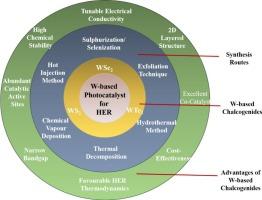高效光催化析氢的w基硫属化合物的最新进展
IF 9.2
2区 工程技术
Q1 ENERGY & FUELS
引用次数: 0
摘要
追求可持续替代能源使人们更加注重可再生替代能源,特别是氢,因为它具有高能量密度和无害环境的燃烧。利用阳光产生氢气的光催化水分解技术,正在成为该领域一种改变游戏规则的方法。在探索的许多材料中,过渡金属二硫族化合物(TMDs),特别是钨基材料(W),因其特殊的光催化性能而引起了人们的极大关注。本文综述了氢基光催化剂的研究进展。随后,本文深入探讨了光催化水裂解的基本原理和析氢反应的机理。综述的核心是对WS2、WSe2和WTe2在制氢中的光催化性能进行评价。通过分析这些材料的结构、电子和催化特性,我们揭示了它们的优势、局限性和未来潜力。最后,我们概述了本综述的范围和观点,旨在为推动光催化辅助制氢技术的未来研究和发展提供见解。本文章由计算机程序翻译,如有差异,请以英文原文为准。

Cutting-edge advances in W-based chalcogenides for efficient photocatalytic hydrogen evolution
The pursuit of sustainable energy alternatives has intensified the focus on renewable alternatives, particularly hydrogen, owing to its high energy density and environmentally benign combustion. Photocatalytic water splitting, which harnesses sunlight to produce hydrogen, is emerging as a game-changing approach in this area. Among the many materials explored, transition metal dichalcogenides (TMDs), especially tungsten-based materials (W), have captured significant attention for their exceptional photocatalytic properties. This review provides a comprehensive analysis of the recent advancements in the field of W-based photocatalysts for hydrogen production. Subsequently, this review delves into the fundamentals of photocatalytic water splitting and the mechanisms underpinning the hydrogen evolution reaction (HER). The core of the review is dedicated to evaluating the photocatalytic performance of WS2, WSe2, and WTe2 in hydrogen generation. By analyzing the structural, electronic, and catalytic features of these materials, we shed light on their strengths, limitations, and future potential. Finally, we outline the scope and perspectives of this review, aiming to provide insights that could drive future research and development in photocatalysis-assisted hydrogen production technologies.
求助全文
通过发布文献求助,成功后即可免费获取论文全文。
去求助
来源期刊

Sustainable Materials and Technologies
Energy-Renewable Energy, Sustainability and the Environment
CiteScore
13.40
自引率
4.20%
发文量
158
审稿时长
45 days
期刊介绍:
Sustainable Materials and Technologies (SM&T), an international, cross-disciplinary, fully open access journal published by Elsevier, focuses on original full-length research articles and reviews. It covers applied or fundamental science of nano-, micro-, meso-, and macro-scale aspects of materials and technologies for sustainable development. SM&T gives special attention to contributions that bridge the knowledge gap between materials and system designs.
 求助内容:
求助内容: 应助结果提醒方式:
应助结果提醒方式:


